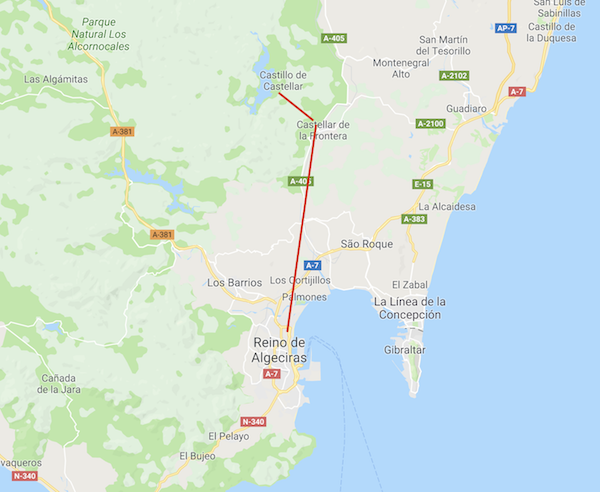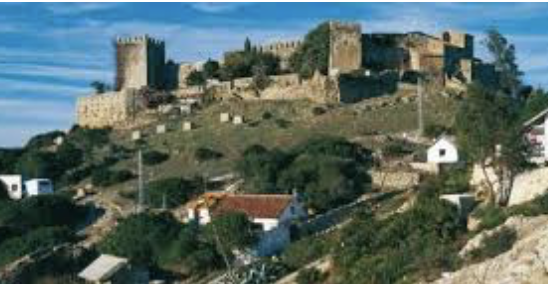Mr Henderson's Railway --
Algeciras to Castellar
This is adapted from a
section of my book on Travels in Spain
Last time I was visiting Gibraltar I decided to take a different route home, and turned left at San Roque, drove to the bottom of the hill where I turned sharp right and headed for Jimena de la Frontera. I am in search of Mr Henderson's Railway.
"But it closed years ago," said my new friend as we sat and chatted on the roof balcony of our hotel, overlooking Algeciras Bay on one side, and the massive Rock of Gibraltar looming over us to the south.
The line was originally built between 1890-92 to enable British garrison officers and their families to escape the claustrophobic atmosphere of Gibraltar and enjoy the surrounding countryside. Travel in Spain was difficult in the nineteenth century. You could not tour Spain by road without great difficulty. Heck, you couldn't tour Spain by road without serious difficulty until the late nineteen-sixties.
The railway was the work of a British engineer, John Morrison, backed by his friend and railway enthusiast Sir Alexander Henderson (1st Baron Faringdon, 1850-1934). Henderson was fascinated by the railways, and was heavily involved in many rail projects in the UK and in South America.
This new line ran from Algeciras to Bobadilla, just outside Ronda, where it met the main line to Madrid. According to the records, when it opened it operated no less than six passenger trains a day through twenty-two stations at the grand cost of 11 pesetas and 65 cents for a first class seat from San Roque to Ronda.

To make the travel easier Henderson arranged for a first class hotel, the Reina Cristina, to be built in Algeciras within walking distance of the station, and overlooking the bay where the packet steamer would bring travellers across from Gibraltar. Apparently the grounds overlooked a sandy beach. Not so today as the port has grown substantially. In fact, the railway line which originally ended right next to the quay when I first visited Algeciras seems to have been moved back somewhat, or the quayside has stretched out into the water considerably.
Another line has disappeared altogether. When I first came to Algeciras and Gibraltar in the sixties we camped on waste land where there is now a massive oil terminal, and one morning we were woken by the terrifying screech of a locomotive that screamed past us at the crack of dawn. That line would appear to be no more.
So proud was the hotel of Algeciras's sub tropical climate that guests were promised a refund on their room rate for any days between May and September spoilt by rain. We could do with a few more enterprising deals like that.
King Alfonso XIII of Spain and his English Queen Ena, who was a granddaughter of Queen Victoria, were frequent visitors, as were a host of famous people since.
The train itself was not renowned for its speed, and was dubbed The Smugglers' Express, because it travelled so slowly up some of the steep inclines that people could sell contraband booze, coffee, and sugar from the train windows. These days the train has a mechanism for overcoming this problem. When the wheels begin to slip sand is released onto the rails to help the wheels grip.
The train still runs on a single track for most of the way. "In the old days before electronic signalling systems were operational, the stationmaster would give the engine driver a cane hoop, which he in turn would hand to the next stationmaster. This procedure would be repeated for trains waiting to travel in the opposite direction, and acted as a fail-safe back-up to the morse code telegraphing system to signal that the line was clear."
And so we set off in search of Mr Henderson's railway. We drove down the nice relatively new and well surfaced highway towards Jimena de la Frontera. Town after town in this region has a name that almost always seems to require the description de la frontera (often abbreviated to fra). The trouble is that back in the middle ages the frontier between Moors and Christians changed so many times that virtually everywhere was on the frontier at some time or another. One of the towns changed masters about ten times over the course of 150 years. Life must have been a real pain.
Now all is peaceful, and we drove over a bridge, and into the valley, and there immediately below us was Mr Henderson's railway, with a freight train approaching a large reclamation depot with trucks filled with crushed metal.
I didn't really want to tramp around an industrial site, so we moved on up the valley. At the village of Almoraima I stopped to photograph the station, and then went on a trip around the nearby new town of Castellar de la Frontera.
The original village dates back to prehistoric times (round about 25,000 BC), and that is quite some heritage. The village is perched on top of a hill, and contains the usual castle. It is quite some castle, and the views are terrific. Unfortunately, on the day I turned up with my camera the weather was dull and cloudy, with rain threatening.
In 1983 the Spanish government expropriated the whole village, declaring it to be an historical and artistic monument. In order to put the place on the map and renovate the almost ruinous buildings the government decided to build a new village down in the valley next to Mr Henderson's railway. This is, of course, Castellar New Town. And they got a new station as well.
From the main road turn right, over the level crossing, then turn left, and there is this new town. It looks rather nice. As new towns go I wouldn't mind living there myself.
This neck of the woods has a rather ancient history. It is listed as the last great rain forest area in Europe. It also has a more primitive form of pine tree still growing in the mountains. Not only that but there is evidence of human habitation going back 30,000 years in this valley. And if you follow Mr Henderson's railway line a little further north you can see the cave drawings.
The more modern history of this site starts with the building of the castle in the tenth century. It was enlarged during the thirteenth and fourteenth centuries. This was civil war time, with the Christians and Muslims at it hammer and tongs over control of southern Spain, with the frontier moving backwards and forwards throughout the whole period.
The castle formed the whole village as was common in feudal times. The main building was the military complex with the lord's private quarters tucked away somewhere inside. Beyond the central military complex was a honeycomb of homes huddled together for protection within the castle walls.

The place was a complete ruin by the nineteen seventies, with only a handful of people living there. The government took possession of the whole area in 1983 and declared it an historical and artistic monument. Eventually the houses were taken over by artists, and there are still artists there, showing paintings, glass work, artistic work using cork, and painted tiles.
There is also a restaurant in one of the houses with an enterprising menu. The eating area is a small couple of rooms and is a bit cramped, and to my mind it doesn't help to have canned music belting out in such close quarters. Please note restaurateurs, the piped muzak turned away a potential customer. Those of us (10-15% of the population) with tinnitus have problems with that particular racket. That means if we eat in muzak-drenched surroundings we cant take part in conversations, which is part of the reason for eating out. I know it may sound odd, but some of us come for the food, not for your crummy record collection.
With the wind blowing a gale and the clouds gathering we drove round and down to the main road, and turned towards Jimena.
<<< The Tuna Coast
|
Subscribe
to our email alerts on the housing markets both
in the UK and abroad.
|
HTML Comment Box is
loading comments...
Podcasts: